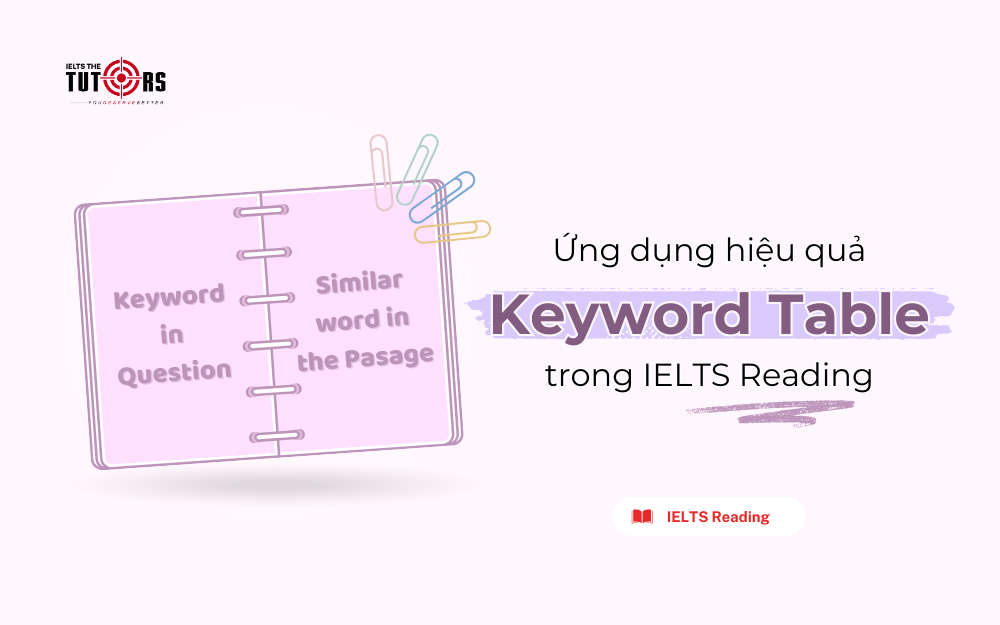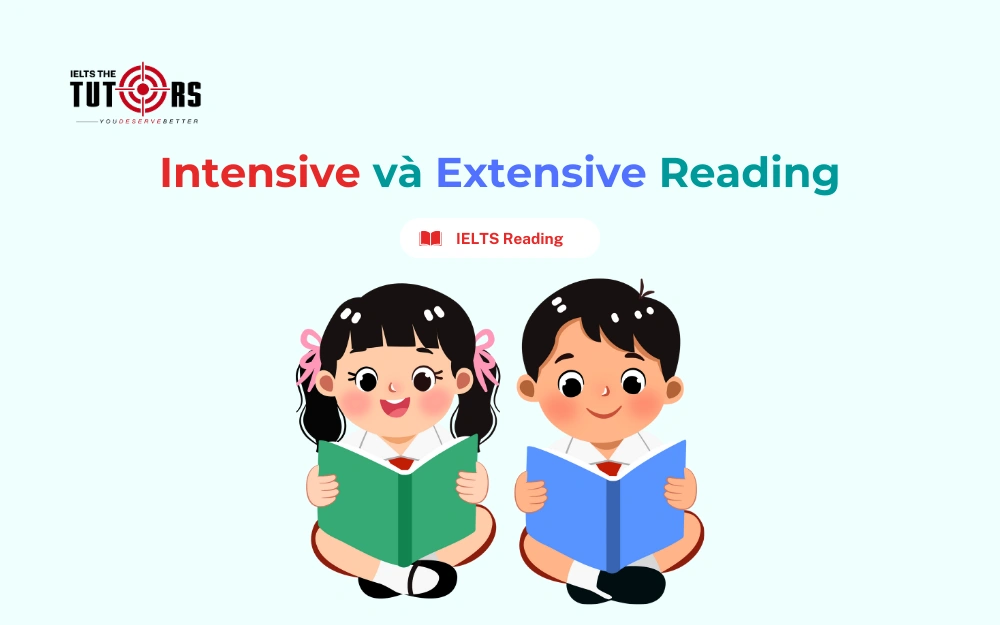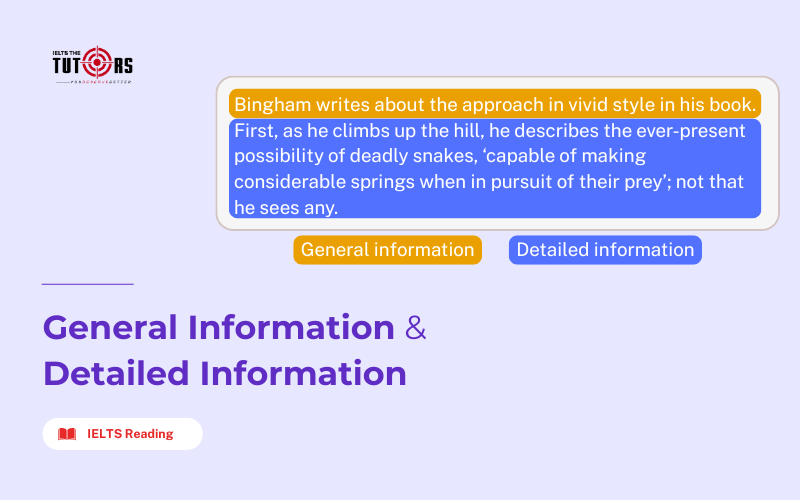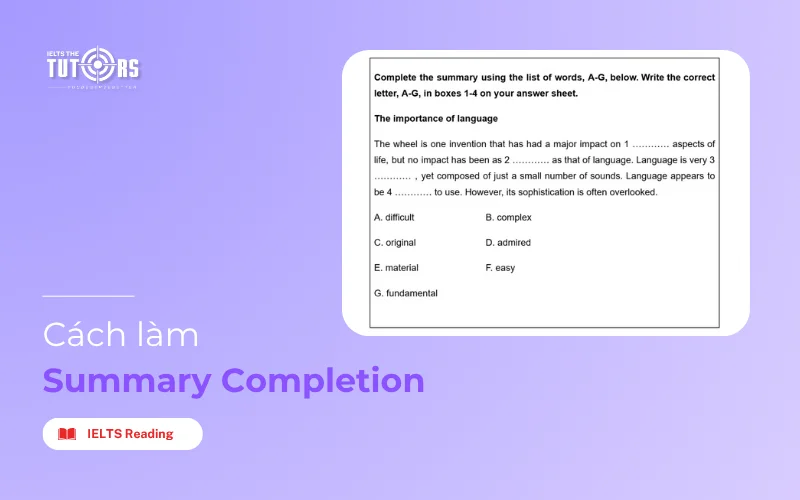
Summary Completion (hoàn thành đoạn tóm tắt) là dạng câu hỏi thường xuyên xuất hiện nhất trong phần thi IELTS Reading. Dạng này kiểm tra khả năng hiểu ý chính, nhận diện thông tin quan trọng và sử dụng từ vựng một cách chính xác. Cùng tìm hiểu về Summary Completion IELTS Reading ngay trong bài viết này để tìm ra cách làm bài hiệu quả nhé!
Tổng quan dạng bài Summary Completion IELTS Reading
Dạng bài Summary Completion trong IELTS Reading yêu cầu thí sinh điền từ hoặc cụm từ vào các chỗ trống trong đoạn văn tóm tắt để hoàn thiện nó một cách hoàn chỉnh. Nội dung của đoạn này có thể là tóm tắt ý của một đoạn trong bài đọc, một vài đoạn hoặc cả bài đọc.
Các dạng câu hỏi trong Summary Completion
Summary Completion IELTS Reading có 2 hình thức chính đó là:
Chọn từ ngữ từ danh sách cho sẵn (word bank):
Đề bài sẽ cho sẵn một danh sách các từ để chọn, thí sinh chọn đáp án đúng từ danh sách này để điền vào chỗ trống, các từ ngữ này có thể được lấy trực tiếp từ bài đọc, từ trái nghĩa với từ cần điền xuất hiện trong bài đọc hoặc là từ đồng nghĩa. Format mẫu:
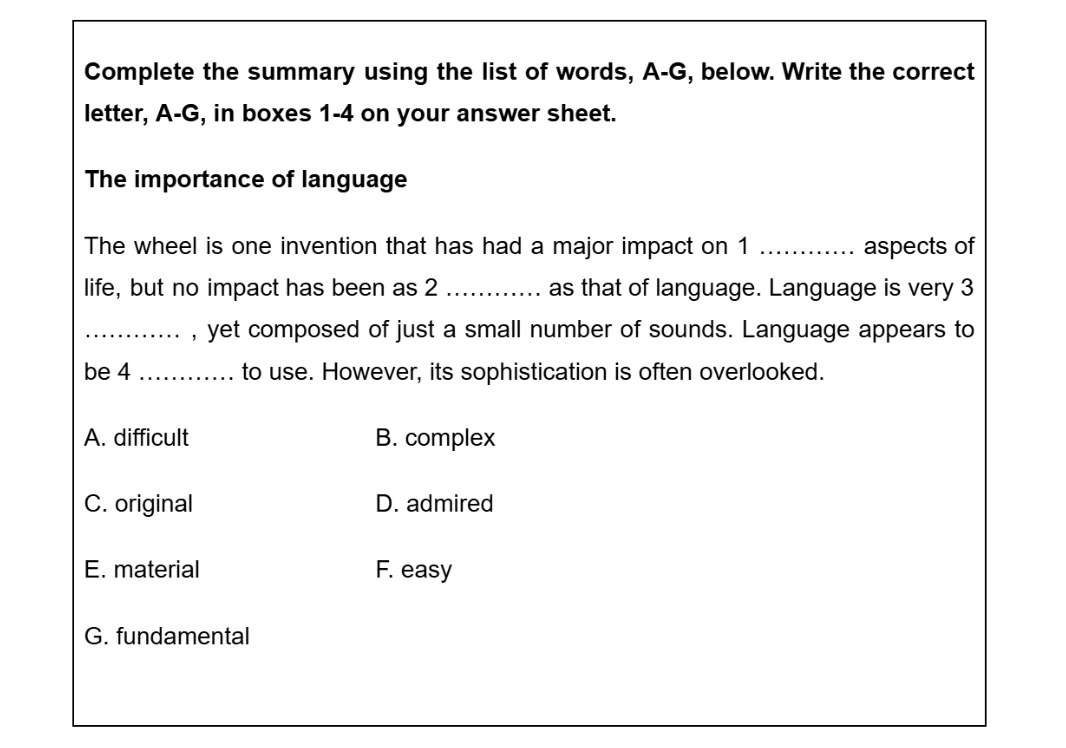
(Nguồn: Cam 11 Test 4)
Điền từ thích hợp từ bài đọc
Đối với hình thức này, thí sinh sẽ phải tự tìm đáp án đúng có trong bài đọc để điền vào đoạn văn trong câu hỏi (thường sẽ có giới hạn về số từ được điền vào chỗ trống, ví dụ: “NO MORE THAN TWO WORDS”). Format mẫu:

(Nguồn: Cam 16 Test 1)
Hướng dẫn làm bài IELTS Reading Summary Completion
Để hiểu rõ hơn về cách làm dạng bài Summary Completion chính xác và hiệu quả, IELTS The Tutors đã hướng dẫn các bạn qua các bước dưới đây và áp dụng vào bài tập minh họa sau:
“The environmental practices of big businesses are shaped by a fundamental fact that for many of us offend our sense of justice. Depending on the circumstances, a business may maximize the amount of money it makes, at least in the short term, by damaging the environment and hurting people. That is still the case today for fishermen in an unmanaged fishery without quotas, and for international logging companies with short-term leases on tropical rainforest land in places with corrupt officials and unsophisticated landowners. When government regulation is effective, and when the public is environmentally aware, environmentally clean big businesses may out-compete dirty ones, but the reverse is likely to be true if government regulation is ineffective and if the public doesn’t care.
It is easy for the rest of us to blame a business for helping itself by hurting other people. But blaming alone is unlikely to produce change. It ignores the fact that businesses are not charities but profit-making companies, and that publicly owned companies with shareholders are under obligation to those shareholders to maximize profits, provided that they do so by legal means. US laws make a company’s directors legally liable for something termed ‘breach of fiduciary responsibility’ if they knowingly manage a company in a way that reduces profits. The car manufacturer Henry Ford was in fact successfully sued by shareholders in 1919 for raising the minimum wage of his workers to $5 per day: the courts declared that, while Ford’s humanitarian sentiments about his employees were nice, his business existed to make profits for its stockholders.”
Questions 27-31
Complete the summary using the list of words, A-J, below.
Write the correct letter, A-J, in boxes 27-31 on your answer sheet.
Big businesses
Many big businesses today are prepared to harm people and the environment in order to make money, and they appear to have no 27………………. . Lack of 28……………….. by governments and lack of public 29………………. can lead to environmental problems such as 30……………….. or the destruction of 31……………….
A funding B trees C rare species
D moral standards E control F involvement
G flooding H overfishing I worker support
Bước 1: Đọc kỹ yêu cầu đề bài
Đề bài yêu cầu đọc và chọn đáp án các từ được liệt kê
Bước 2: Đọc lướt đoạn tóm tắt và gạch chân keyword
Many big businesses today are prepared to harm people and the environment in order to make money, and they appear to have no 27………………. . Lack of 28……………….. by governments and lack of public 29………………. can lead to environmental problems such as 30……………….. or the destruction of 31………………
Đoạn tóm tắt này cho ta thấy các hậu quả của các company và sự thiếu.
Thường nên gạch các từ khóa thời gian, tên riêng, danh từ và động từ chính trong câu.
Bước 3: Dự đoán loại từ cần điền
Many big businesses today are prepared to harm people and the environment in order to make money, and they appear to have no 27 + danh từ (liên quan đến business thiếu/ không có gì để kiếm tiền). Lack of 28 + danh từ (liên quan đến sự thiếu của government) by governments and lack of public 29 + danh từ (liên quan đến sự thiếu/ không để của public) can lead to environmental problems such as 30 + danh từ (liên quan đến vấn đề môi trường được đề cập trong bài) or the destruction of 31 + danh từ (liên quan đến sự phá hủy)
Bước 4: Tìm vị trí thông tin trong bài đọc
Scan thông tin trong đoạn tóm tắt ta có thể thấy câu trả lời nằm ở đoạn số 1 (liên quan đến big business và hậu quả)
Bước 5: So sánh và điền đáp án
Many big businesses today are prepared to harm people and the environment in order to make money, and they appear to have no 27……………….
…Depending on the circumstances, a business may maximize (=make) the amount of money it makes, at least in the short term, by damaging (=harm) the environment and hurting (=harm) people…fishermen in an unmanaged fishery…corrupt officials and unsophisticated landowners → đưa ra các hậu quả cho thấy nhưng công ty lớn làm
Chúng ta có các đáp án sau → D chính là đáp án phù hợp nhất để tóm tắt ý của câu này (moral standards: tiêu chuẩn đạo đức)
A funding B trees C rare species
D moral standards E control F involvement
G flooding H overfishing I worker support
Lack of 28……………….. by governments and lack of public 29……………….
Ở câu 28, 29 có thể dễ dàng tìm ra đáp án khi đọc câu tiếp theo trong đoạn.
When government regulation is effective, and when the public is environmentally aware, environmentally clean big businesses may out-compete dirty ones, but the reverse (sự ngược lại) is likely to be true (có xu hướng đúng) if government regulation is ineffective and if the public doesn’t care.
Vậy suy ra được, lack of regulation by government → đáp án là câu E control (sự kiểm soát)
lack of public care → đáp án là câu F (sự tham gia)
can lead to environmental problems such as 30……………….. or the destruction of 31……………….
Lúc này mình sẽ cần coi lại chỗ hậu quả để tìm đáp án
That is still the case today for fishermen in an unmanaged fishery without quotas, and for international logging companies with short-term leases on tropical rainforest land in places with corrupt officials and unsophisticated landowners.
environmental problems such as unmanaged fishery → đáp án là H overfishing (đánh bắt cá quá mức)
destruction of tropical rainforest → đáp án là B trees
Đây là một bài mẫu để bạn có thể tham khảo cách làm dạng bài Summary completion, đôi khi đáp án sẽ nằm không theo thứ tự nhưng thường nằm trong các đoạn gần nhau.
Xem thêm:
Một số lưu ý khi giải quyết Summary Completion IELTS Reading
Mỗi dạng bài đều có cách giải quyết khác nhau, đối với Summary Completion trong IELTS Reading, bạn cần lưu ý những điều sau để tối ưu điểm số:
- Thứ tự của câu hỏi trong Summary Completion giống với thứ tự xuất hiện thông tin cần điền trong nội dung của bài đọc. Vì thế bạn có thể làm bài lần lượt theo thứ tự. Trong trường hợp không tìm thấy đáp án cho câu đầu tiên, bạn hãy bỏ qua và tiếp tục tìm đáp án cho câu thứ 2 nhé.
- Hãy cố gắng hiểu nội dung chính của đoạn văn và cả bài văn thay vì chỉ dựa vào ngữ pháp để điền từ thích hợp vào chỗ trống. Bên cạnh đó, hãy chú ý đến ngữ cảnh của câu để xác định từ cần điền vào là phù hợp.
- Vì là dạng tóm tắt nội dung, nên đoạn văn có thể được tác giả thu gọn lại bằng các từ khóa quan trọng và có thể bị paraphrase lại để khác đi các từ khóa bạn đã gạch chân trong phần summary ở câu hỏi. Giải pháp ở đây là bạn hãy chú ý đến những từ khóa không thể thay đổi trong bài (như tên riêng, con số, những từ khó có thể thay thế, …), điều này giúp bạn dễ dàng xác định vị trí và đối chiếu thông tin trong bài đọc với câu hỏi.
- Không nên dành quá nhiều thời gian để trả lời một câu hỏi, nếu chưa tìm được đáp án, bạn có thể làm những câu khác dễ tìm đáp án hơn, sau đó hãy quay lại câu chưa làm được. Điều này giúp bạn tránh mất nhiều thời gian để xử lý một câu, bên cạnh đó khi bạn đã làm xong các câu khác rồi lại hiểu hơn về đoạn văn cũng như có thêm thông tin để trả lời câu khó.
Bài tập vận dụng
Paragraph
C. Vertical integration is the other key component in the rise of the Hollywood studio system. The major studios realized they could increase their profits by handling each stage of a film’s life: production (making the film), distribution (getting the film out to people) and exhibition (owning the theaters in major cities where films were shown first). Five studios, ‘The Big Five’, worked to achieve vertical integration through the late 1940s, owning vast real estate on which to construct elaborate sets. In addition, these studios set the exact terms of films’ release dates and patterns. Warner Bros., Paramount, 20th Century Fox, MGM and RKO formed this exclusive club. ‘The Little Three’ studios – Universal, Columbia and United Artists – also made pictures, but each lacked one of the crucial elements of vertical integration. Together these eight companies operated as a mature oligopoly, essentially running the entire market.
D. During the Golden Age, the studios were remarkably consistent and stable enterprises, due in large part to long-term management heads – the infamous ‘movie moguls’ who ruled their kingdoms with iron fists. At MGM, Warner Bros, and Columbia, the same men ran their studios for decades. The rise of the studio system also hinges on the treatment of stars, who were constructed and exploited to suit a studio’s image and schedule. Actors were bound up in seven-year contracts to a single studio, and the studio boss generally held all the options. Stars could be loaned out to other production companies at any time. Studio bosses could also force bad roles on actors, and manipulate every single detail of stars’ images with their mammoth in-house publicity departments. Some have compared the Hollywood studio system to a factory, and it is useful to remember that studios were out to make money first and art second.
E. On the other hand, studios also had to cultivate flexibility, in addition to consistent factory output. Studio heads realized that they couldn’t make virtually the same film over and over again with the same cast of stars and still expect to keep turning a profit. They also had to create product differentiation. Examining how each production company tried to differentiate itself has led to loose characterizations of individual studios’ styles. MGM tended to put out a lot of all-star productions while Paramount excelled in comedy and Warner Bros, developed a reputation for gritty social realism. 20th Century Fox forged the musical and a great deal of prestige biographies, while Universal specialized in classic horror movies.
F. In 1948, struggling independent movie producers and exhibitors finally triumphed in their battle against the big studios’ monopolistic behavior. In the United States versus Paramount federal decree of that year, the studios were ordered to give up their theaters in what is commonly referred to as ‘divestiture’ – opening the market to smaller producers. This, coupled with the advent of television in the 1950s, seriously compromised the studio system’s influence and profits. Hence, 1930 and 1948 are generally considered bookends to Hollywood’s Golden Age.
Questions 24-26
Complete the summary below. Choose NO MORE THAN TWO WORDS from the passage for each answer.
THE HOLLYWOOD STUDIOS
Throughout its Golden Age, the Hollywood movie industry was controlled by a handful of studios. Using a system known as 24………………………………, the biggest studios not only made movies but handled their distribution and then finally showed them in their theaters. These studios were often run by autocratic bosses – men known as 25…………………………………, who often remained at the head of organizations for decades. However, the domination of the industry by the leading studios came to an end in 1948, when they were forced to open the market to smaller producers – a process known as 26…………………………
Bước 1: Đọc và tìm hiểu kĩ đề bài
Đề bài yêu cầu làm tóm tắt và không được điền quá hai từ vào chỗ trống.
Bước 2: Đọc lướt và tìm ý chính
Đọc lướt đoạn có thể thấy đoạn tóm tắt này nói về các Hollywood studios trong thời đại hoàng kim (Golden Age) và chuyện xảy ra ở năm 1948.
Bước 3: Dự đoán loại từ cần điền
Throughout its Golden Age, the Hollywood movie industry was controlled by a handful of studios. Using a system known as 24 + danh từ (liên quan đến tên của system được sử dụng bởi các studios để kiểm soát nền công nghiệp phim), the biggest studios not only made movies but handled their distribution and then finally showed them in their theaters. These studios were often run by autocratic bosses – men known as 25 + danh từ (số nhiều, chỉ người đàn ông là sếp của các theaters, người thường làm một vị trí khá lâu), who often remained at the head of organizations for decades. However, the domination of the industry by the leading studios came to an end in 1948, when they were forced to open the market to smaller producers – a process known as 26 + danh từ (liên quan đến tên của một quá trình mà studios bị bắt mở thị trường với những quá trình nhỏ hơn)
Bước 4: Tìm vị trí thông tin
Throughout its Golden Age, the Hollywood movie industry was controlled by a handful of studios. Using a system known as 24………………………………, the biggest studios not only made movies but handled their distribution and then finally showed them in their theaters. → đoạn C
These studios were often run by autocratic bosses – men known as 25…………………………………, who often remained at the head of organizations for decades. → đoạn D
However, the domination of the industry by the leading studios came to an end in 1948, when they were forced to open the market to smaller producers – a process known as 26…………………………
Bước 5: So sánh và điền đáp án
Throughout its Golden Age, the Hollywood movie industry was controlled by a handful of studios. Using a system known as 24………………………………, the biggest studios not only made movies but handled their distribution and then finally showed them in their theaters.
Đoạn C: Vertical integration is the other key component in the rise of the Hollywood studio system. The major studios (= biggerst studios) … where films were shown first).
→ đáp án 24 là vertical intergration
These studios were often run by autocratic bosses – men known as 25…………………………………, who often remained at the head of organizations for decades.
Đoạn D: During the Golden Age… the infamous ‘movie moguls’ who ruled their kingdoms (often run by) with iron fists…the same men ran their studios for decades.
→ đáp án 25 là movie moguls
However, the domination of the industry by the leading studios came to an end in 1948, when they were forced to open the market to smaller producers – a process known as 26…………………………
Đoạn F: In 1948,…In the United States versus Paramount federal decree of that year, the studios were ordered to give up (=were forced) their theaters in what is commonly referred to as ‘divestiture’ – opening the market to smaller producers.
→ đáp án 26 là divestiture
Như vậy là chúng ta vừa khám phá ra cách làm của thêm một dạng bài nữa trong IELTS Reading đó là Summary Completion. Dạng bài này yêu cầu kỹ năng đọc nhanh, tìm từ khóa và xác định đúng từ cần điền. Áp dụng chiến lược làm bài khoa học sẽ giúp bạn nâng cao điểm số và tự tin hơn khi đối mặt với bài thi. Hãy luyện tập thường xuyên để nhanh chóng đạt được kết quả tốt nhé.





